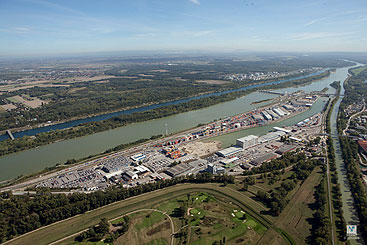Sustainable transport policy at work at the Port of Vienna
Sharing its expertise in waste collection and waste treatment, the Port of Vienna
proves it can play a significant role for sustainable transport in the EU Strategy
for the Danube Region.


In the WANDA project, the Port of Vienna conducted field surveys on waste collection in the ports of Lobau, Albern and Freudenau to develop suggestions for more efficient waste management on ships and in the port.
The Port of Vienna is one of the largest cargo transport centres in Austria. Its excellent geographical position and trimodal cargo handling make it an efficient hub for international goods and passenger transport.
The Port of Vienna spans a surface area of approximately 350 hectares, and consists of three cargo ports. The Port of Freudenau handles cars, storage goods and bulk goods. One of the largest storage areas in Austria is located here, as well as the largest Combi Terminal at the Danube. In the Port of Lobau, oil is transported via ship on the Danube and is then stored or handled in the port. Albern port hosts mainly facilities for grain and bulk goods.
Sustainable use of the waterway. For the port of Vienna, sustainable transport policy means effectively combining water, rail and road networks. Its strategic objective is to develop and implement projects that involve the Danube as an important part of the transport chain. As one of the most important intersections along the Danube axis and a hub for south-east Europe, the Port of Vienna also has a significant role to play in the EU’s strategy for the Danube Region.
The project ‘Waste Management for Inland Navigation on the Danube’ (WANDA) was launched in 2009 to coordinate the development of the collection of ships’ waste along the Danube. The aim of WANDA, under leadership from via donau, was to find common solutions for a sustainable, environmentally sound and cross-border coordinated approach to ship waste management for cargo vessels along the Danube.
Developing pilot programmes. In the WANDA project, the Port of Vienna brought in its expertise in waste collection and waste treatment, and field surveys on waste collection were conducted in the ports of Lobau, Albern and Freudenau to develop suggestions for more efficient waste management on ships and in the ports.
The project organised separate waste collection of oil, waste and other used materials and the Port of Vienna participated in pilot tests for a mobile ship waste collection vessel, which lead to an overall collection of oily waste water of about 400 m. Waste water was collected directly where produced, which led to a large reduction of deposits in the port itself.
More work to be done. Newly established waste collection stations were not as well received in the Albern and Lobau Ports; for the most part they were not used for their purpose. More efforts will have to be made to raise awareness of the need to separate waste directly on the ship to secure waste separation at the deposit units.
The port of Vienna will continue to participate in the follow-up project Convention for Waste Management for Inland Navigation on the Danube (CO-WANDA), which began in October 2012. It will be important to generate a legal framework to arrive at joint regulations along the Danube River, but the results of WANDA clearly show the necessity to manage waste generated on inland waterways.





